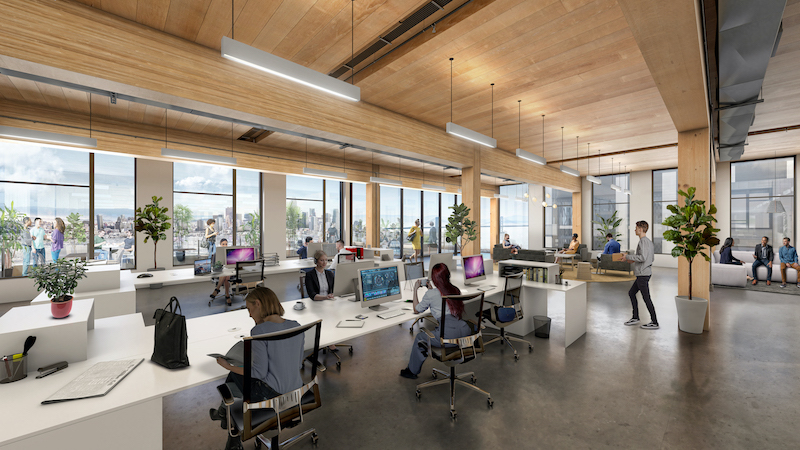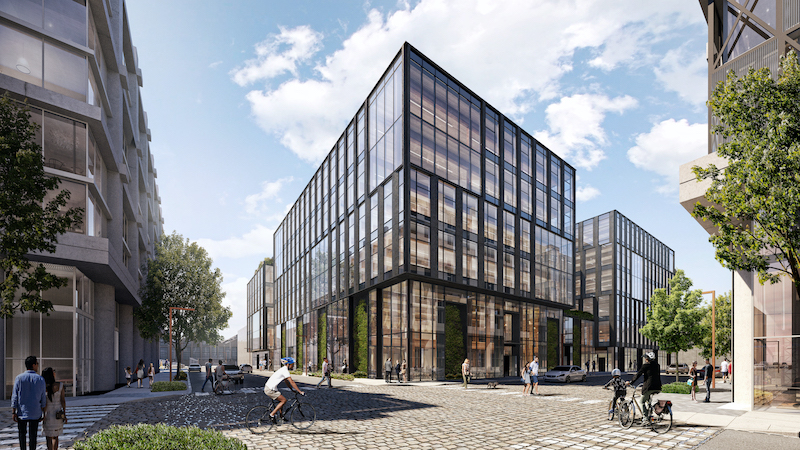The race for the biggest, tallest, boldest mass timber building is officially on.
The developer Brookfield Properties disclosed yesterday its intention to build a 310,000-sf, 85-ft-tall office building in San Francisco that will feature cross laminated timber floor slabs and glue-laminated timber columns and beams.
The project—known as Pier 70 Parcel A—will be part of Brookfield’s 28-acre $3.5 billion Pier 70 waterfront development. With this project—whose construction is scheduled to begin next spring—Brookfield lays claim to the largest office building made from mass timber in North America.
The project is subject to design approvals by the city and the Port of San Francisco. The design architect on this project is Hacker Architects, and the GC is Swinerton. The CLT and glulam components will be assembled with steel lateral seismic framing, and clad with metal panels finished to appear as raw weathered steel.
The six-story building’s interior will feature one- and two-story ceiling heights, and windows that range from 14 to 28 ft high. A cantilevered section will extend on four sides, with each corner used as a switching point for the direction of the beams.
Brookfield estimates that, by using mass timber, it will cut the building’s construction time by four to six months, compared to a similar sized concrete building. (Construction is scheduled for completion in the spring of 2022.)
See also: The University of Arkansas is now home to America’s largest mass timber building
Brookfield and Hacker point to other benefits from building with mass timber: its lower carbon footprint, its contribution to the building’s biophilic design, and its fire resistance compared to steel.
“The experience of a wood building is one of softness, depth, and light that makes it feel more expansion beyond its boundary,” said Corey Martin, a Principal with Hacker, in a prepared statement. “This building will have views through the structure to showcase the wood, the Bay, and pedestrian activity.” (Brookfield intends to include a retailer, restaurant, and bike lounge at the ground floor.)

Aside from its lower carbon footprint, mass timber's aesthetic qualities are appealing to designers.
Pier 70 won’t be the first mass timber building in San Francisco, however. That honor will go to 1 De Haro, an four-story 60-ft-high office building developed by SKS Partners and designed by Perkins and Will. “Basically, it’s a very sophisticated Lincoln Logs set,” John Fisher, SKS Partners’ project manager, told the San Francisco Chronicle. “That’s how we explained it to our investors.” California College of the Arts is expected to break ground next spring on three pavilions made from mass timber on a concrete base.
California, which included mass timber in its building code in 2016, is playing catchup with other states—mostly in the Pacific Northwest—where mass timber has gained acceptance. Suppliers are responding to this demand, with three—Katerra, Vaagen Timbers, and SmartLam (through an acquisition)—having brought factories online this year that doubled the mass timber production capacity in the U.S., says Erica Spiritos, Swinerton Mass Timber’s preconstruction manager.
In October SmartLam—which now operates factories in Montana and Alabama—announced that it was planning to open CLT manufacturing facilities in ”major wood baskets” across North America. It will open three of these factories by 2022, which would increase the company’s overall annual production capacity to more than 17.2 million cubic feet.
British Columbia-based Structurlam, the leading supplier of mass timber in North America, on Dec. 9 announced that it would spend $90 million to open its first U.S. manufacturing plant, in Conway, Ark. Walmart, which has invested in Structurlam, will use 1.1 million cubic ft of mass timber—produced from Arkansas-grown trees—in the construction of its new Home Office campus. Structurlam's Conway plant—a retrofit of an old steel plant—is scheduled to open in mid 2021.
Another potential game changer could be the 2021 International Building Code that will include Tall Mass Timber provisions which allow the use of mass timber for buildings as high as 18 stories. Several tall-mass-timber projects have already been proposed in the U.S. in anticipation of the code provisions.
Related Stories
| Aug 11, 2010
New data shows low construction prices may soon be coming to an end
New federal data released recently shows sharp increases in the prices of key construction materials like diesel, copper and brass mill shapes likely foreshadow future increases in construction costs, the Associated General Contractors of America said. The new November producer price index (PPI) report from the Bureau of Labor Statistics provide the strongest indication yet that construction prices are heading up, the association noted.
| Aug 11, 2010
LEED 2009 cites FloorScore Certification as indicator of indoor air quality
The U.S. Green Building Council (USGBC) has cited FloorScore® certified flooring products as eligible for credits under the new LEED 2009 Version 3 guidelines. Reflecting the inclusion of FloorScore, the new LEED IEQ Credit 4.3 for Low-Emitting Materials has been expanded from “Carpet Systems” to “Flooring Systems” to include hard surface flooring.
| Aug 11, 2010
Southern Pine Council releases certification survey results
Recent surveys conducted by the Southern Forest Products Association (SFPA) and Random Lengths assessed the use of forest certification programs in the wood products industry and uncovered interesting results, including the fact that approximately 61% do not use a certification system and that about 60% of southern pine producers receive regular requests for certified products.
| Aug 11, 2010
Best AEC Firms of 2011/12
Later this year, we will launch Best AEC Firms 2012. We’re looking for firms that create truly positive workplaces for their AEC professionals and support staff. Keep an eye on this page for entry information. +
| Aug 11, 2010
AAMA leads development of BIM standard for fenestration products
The American Architectural Manufacturers Association’s newly formed BIM Task Group met during the AAMA National Fall Conference to discuss the need for an BIM standard for nonresidential fenestration products.
| Aug 11, 2010
Pella Corporation ranks highest in customer satisfaction
Pella Corporation has earned the prestigious J.D. Power and Associates award for “Highest in Customer Satisfaction among Window and Patio Door Manufacturers” for the third year in a row.
| Aug 11, 2010
Pella introduces BIM models for windows and doors
Pella Corporation now offers three-dimensional (3D) window and door models for use in Building Information Modeling (BIM) projects by architects, designers, and others looking for aesthetically correct, easy-to-use, data-rich 3D drawings.
| Aug 11, 2010
AAMA developing product-based green certification program for fenestration
The American Architectural Manufacturers Association is working on a product-based green certification program for residential and commercial fenestration, the organization announced today. AAMA will use the results of a recent green building survey to help shape the program. Among the survey's findings: 77% of respondents reported a green certification program for fenestration would benefit the product selection process for their company.
| Aug 11, 2010
AIA Course: Enclosure strategies for better buildings
Sustainability and energy efficiency depend not only on the overall design but also on the building's enclosure system. Whether it's via better air-infiltration control, thermal insulation, and moisture control, or more advanced strategies such as active façades with automated shading and venting or novel enclosure types such as double walls, Building Teams are delivering more efficient, better performing, and healthier building enclosures.
| Aug 11, 2010
World's tallest all-wood residential structure opens in London
At nine stories, the Stadthaus apartment complex in East London is the world’s tallest residential structure constructed entirely in timber and one of the tallest all-wood buildings on the planet. The tower’s structural system consists of cross-laminated timber (CLT) panels pieced together to form load-bearing walls and floors. Even the elevator and stair shafts are constructed of prefabricated CLT.







